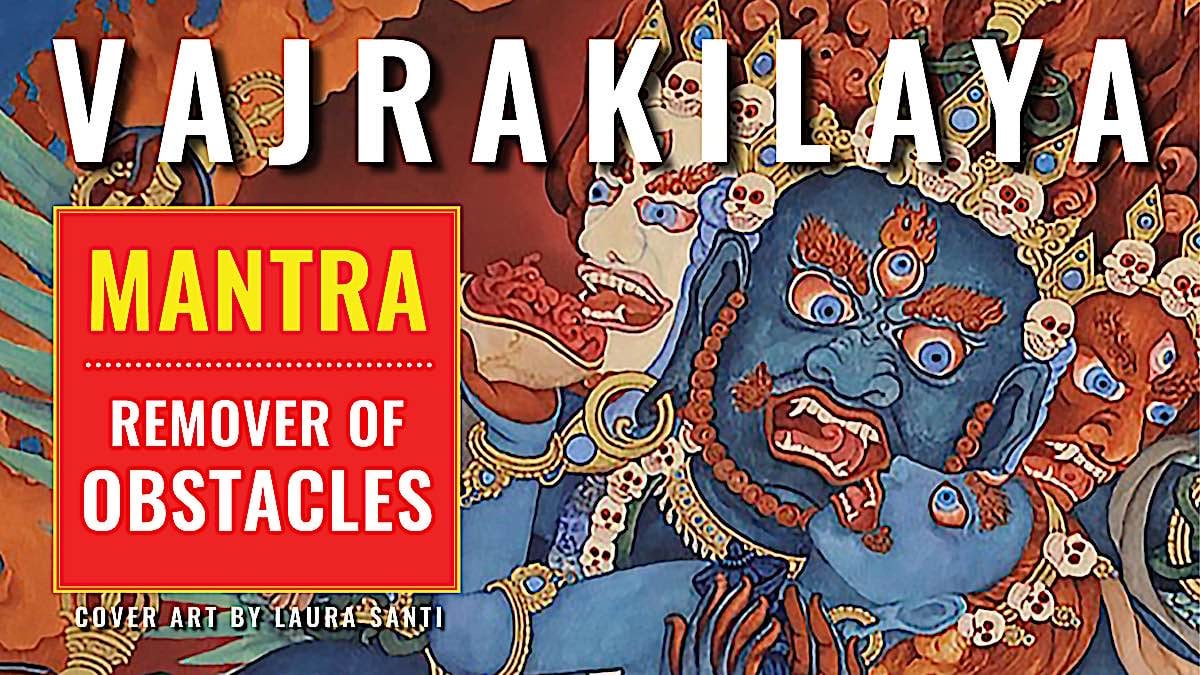
Vajrakilaya and his mantra is important in our modern world — since Vajrakilaya is the activity of all the Buddhas. He is the wrathful Heruka emanation of glorious Buddha Vajrasattva. At the same time, he is the ultimate expression of Bodhichitta and compassion and love.
Listen or chant along with the Sanskrit version of his mantra — famous for accomplishing the Enlightened activities and overcoming our obstacles, chanted beautifully by Hrishikesh Sonar with beautiful meditative images.
Om Vajra Kili Kilaya Sarva Vighnam Vam Hum Pey
CREDITS
Original music, singing and arrangement by Hrishikesh Sonar
Vajrakilaya painting by Laura Santi Sacred Art>>
Statue closeups courtesy of Nepal’s Best Statues — for a feature on this 3rd generation statue maker, see Buddha Weekly pictorial illustrated feature>>
The literal translation of the mantra
Although mantras can’t be broken down by word translation — ideally, listen to full commentaries from teachers on the deeper meanings — for helpful reference, we have translated the Sanskrit mantra somewhat literally here.
Om Vajra Kili Kilaya Sarva Vighnam Vam Hum Pey
Vajra
Vajra, in Sanskrit, has both the meanings of “thunderbolt” and “diamond.” Like the thunderbolt, the vajra cleaves through ignorance. It also connotes “swift” or “instant.”
Kili
Kila : in Sansrit कील; IAST: kīla for a three-sided peg, stake, or knife. Kili associated with Quick Activity, Quick Action, Strength — as in the small three-cornered tent peg that can secure a tent against the worse weather. But also “staking” quickly or pegging instantly.
Kilaya
VajraKilaya is the name of the great One, in this a form of Vajrakila (which means Thunderbolt quickly “Spike” or nail down — as in transfixing our obstructions to Enlightenment.
Sarva
Sarva (सर्व) Sanskrit — Sarva (सर्व) refers to “(the attainment of) everything”
Vighnam
Noun. विघ्न • (vighna) m. a breaker, destroyer. an obstacle, impediment, hindrance, opposition, prevention, interruption, any difficulty or trouble.
Vam
(Bam in Tibetan) Vam is the seed syllable of Vajrakilaya — although Hum is also considered his ultimate seed syllable (Dharmakaya seed syllable). Vam is the bija, or seed, sound of the sacral chakra. When chanting the mantra, vam, the power of the sound vibrations is believed to cleanse this chakra, which is the energy center of creativity
Hum
Hum connotes “method and wisdom” or “Compassion and comprehension of Shunyata”
Pey (Phet, Phat)
Note: this is a phonetic spelling: it is a slightly aspirated sound like P-Hey (with a soft “tuh” sound at the end) — hard to pronounce so most people, chant “pey!”)
Pey means “cutting through” or “cut!” — as in cutting all obstacles to success, siddhis and Enlightenment.
Typically, online you’ll find this mantra chanted in the Tibetan version
OM BENZA KILI KILIYA SARWA BIGHANEN BAM HUNG PHAT

